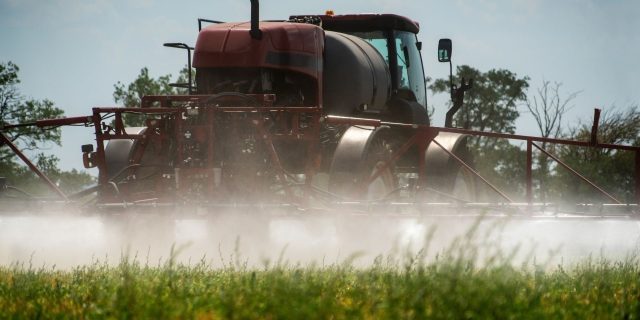25
Oct
Fungicide Use Harms Beneficial Soil Life, Jeopardizes Crop Yields

(Beyond Pesticides, October 25, 2022) Fungicide use harms soil and jeopardizes crop yields by reducing the prevalence of arbuscular mycorrhizal fungi (AMF), according to recent research published in Nature Ecology and Evolution. AMF are important fungi that form symbiotic relationships with plants in both natural and cropland soils, and their presence helps facilitate nutrient uptake, particularly for phosphorus. With global phosphorus supplies dwindling and persistent pollution problems from the nutrient, practices that enhance the presence of AMF in cropland soils will be critical for the future of farming worldwide.
Scientists set out to better understand the conditions that promote AMF’s ability to transfer phosphorus (P) to plants by considering climate and soil characteristics, soil type, and agricultural practices. To start, samples were taken from 150 cropland soils and 60 natural grassland soils in various countries throughout Europe. Environmental data and soil samples were collected for each location, as were past management practices for the cropland sites, which generally all grew cereal grains like wheat, oats or barley. To understand the P transfer rates of AMF hyphae, scientists grew the plant Plantago lanceolata in the collected soils in a greenhouse, utilizing the radioisotope 33P in order to achieve a real-time view of P transport by AMF hyphae. Plantago lanceolata, also known as English plantain, is commonly considered a weed but acted as an an ideal specimen for the experiment given its known ability to form associations with a range of different AMF species. As the plantains grew, 33P was injected at week ten, and 12 days later the plants were harvested and assessed for the amount of 33P taken up from the soil.
The natural grassland soils took up 64% more 33P than soils from the cropland sites. Analysis also finds that AMF richness and microbial biomass was lower in croplands soils by 41% and 29% respectively, with these soils having significantly more available P than in natural grassland soil. Using a statistical model, scientists worked out the relative importance of various conditions and management practices to P transfer and uptake by AMF. The strongest correlation was found for soil pH, which significantly increased P uptake in both soils.
In cropland soils, AMF richness (i.e., the total number of AMF species present within a given soil) and fungicide use were the most important predictors of P transfer and uptake. Cropland soils that were not treated with a fungicide had an average P transfer 2.3 times greater than soils that had three fungicide applications over the last year in the study. In fact, P recovery rates decreased in tandem with the number of each additional fungicide application. Unsurprisingly, scientists found evidence for fungicides diminishing AMF richness, thereby reducing P uptake.
“Our results…call for reconsidering the design of agricultural systems to be able to make full use of the potential of AMF symbiosis for plant nutrition,” the study reads. “For example, applying agroecological techniques, such as crop diversification, can be a promising way to reduce disease pressure, and hence the need to use pesticides, while at the same time promoting AMF richness, which could indirectly support plant P uptake [] and to other benefits provided by AMF.”
Most domesticated crops grown today are not bred to have a symbiotic relationship with AMF. Scientists say that should be an area of further exploration. As the study indicates, “[T]he breeding and use of AMF-responsive crops, an aspect which hasn’t been directly investigated in this study, is a way to promote AMF-supported crop production that requires further consideration in future research.”
The use of fungicides presents a range of hazards beyond harm to soil life. In the environment, their use can induce trophic cascades that result in an overgrowth of algae. Certain fungicide classes, like the strobilurins, have been linked to genetic changes similar to autism and Alzheimer’s disease, and there is evidence that one fungicide, fludoxonil, decreases the body’s ability to fight back against covid-19. Rampant use of these chemicals is putting the human species at risk of another pandemic, as deadly fungal infections are becoming increasingly prevalent in hospitals, and strong evidence is pointing to agriculture as the incubator for these virulent strains of otherwise common fungi like Candida auris and Aspergillus fumigatus.
Help promote the best alternative to chemical agriculture by joining efforts to maintain the integrity of organic production. Organic agriculture does not allow the use of synthetic pesticides, and includes a mandate to maintain or improve soil on the farm. It is critical for consumers to engage with the organic standards process to ensure that agrichemical interests and the U.S. Department of Agriculture do not undermine efforts towards continuously improving organic production practices. Visit Beyond Pesticides Keep Organic Strong and Action of the Week archives for steps you can take to defend organic standards.
All unattributed positions and opinions in this piece are those of Beyond Pesticides.
Source: Nature Ecology and Evolution











I just learned most or all tulips are dipped in fungicide. Does this amount of of fungicide harm soil life (or other life) when bulbs are planted?
April 24th, 2023 at 11:39 amFungicide use poses risks to soil life and crop yields, highlighting the need for sustainable farming practices that balance pest control without harming beneficial organisms in the soil.
December 19th, 2023 at 1:08 am